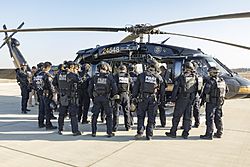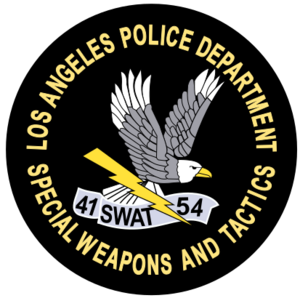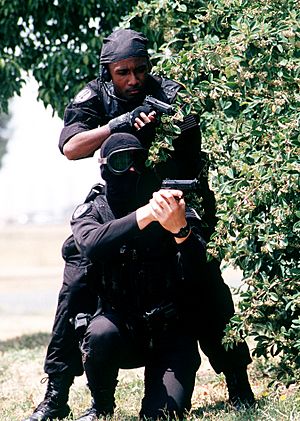SWAT facts for kids
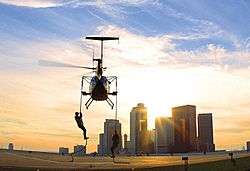
In the United States, a SWAT (special weapons and tactics) team is a generic term for a police tactical unit.
SWAT units are generally trained, equipped, and deployed to resolve "high-risk situations", often those regular police units are not trained or equipped to handle, such as shootouts, standoffs, raids, hostage-takings, and terrorism. SWAT units are equipped with specialized weapons and equipment not normally issued to regular police units, such as automatic firearms, high-caliber sniper rifles, stun grenades, body armor, ballistic shields, night-vision devices, and armored vehicles, among others. SWAT units are often trained in special tactics such as close-quarters combat, door breaching, crisis negotiation, and de-escalation.
The first SWAT units were formed in the 1960s to handle riot control and violent confrontations with criminals. The number and usage of SWAT units increased in the 1980s and the 1990s following incidents such as the North Hollywood shootout, with further increases in the 2000s for counterterrorism interests in the aftermath of the September 11 attacks. In the United States by 2005, SWAT teams were deployed 50,000 times every year, almost 80% of the time to serve search warrants. By 2015, the number of annual SWAT deployments had increased to nearly 80,000 times a year.
Contents
Definition
The United States National Tactical Officers Association's definition of SWAT is:
SWAT: A designated law enforcement team whose members are recruited, selected, trained, equipped and assigned to resolve critical incidents involving a threat to public safety which would otherwise exceed the capabilities of traditional law enforcement first responders and/or investigative units.
History
Riots and political conflicts of the 1960s
According to the Historical Dictionary of Law Enforcement, the term "SWAT" was used as an acronym for the "Special Weapons and Tactics" established as a 100-man specialized unit in 1964 by the Philadelphia Police Department in response to an alarming increase in bank robberies. The purpose of this unit was to react quickly and decisively to bank robberies while they were in progress, using a large number of specially trained officers who had a great amount of firepower at their disposal. The tactic worked and was used to resolve other types of incidents involving heavily armed criminals. The Los Angeles Police Department (LAPD) Special Weapons and Tactics was established in 1967. LAPD inspector Daryl Gates envisioned the "SWAT" acronym to be "Special Weapons Attack Team" but this was not accepted by deputy chief Edward M. Davis who instead approved Special Weapons and Tactics.
The LAPD promoted what became known as SWAT teams for a variety of reasons. After the racially-charged Watts riots in Los Angeles in August 1965, the LAPD began considering tactics it could use when faced with urban unrest, rioting, or widespread violence. Daryl Gates, who led the LAPD response to the riots, would later write that police at the time did not face a single mob, but rather "people attacking from all directions". New York University professor Christian Parenti has written that SWAT teams were originally conceived of as an "urban counterinsurgency bulwark".
Another reason for the creation of SWAT teams was the fear of lone or barricaded gunmen who might outperform police in a shootout, as happened in Austin with Charles Whitman.
After the LAPD's establishment of its own SWAT team, many law enforcement agencies in United States established their own specialized units under various names. Gates explained in his autobiography Chief: My Life in the LAPD that he neither developed SWAT tactics nor the associated and often distinctive equipment; but that he supported the underlying concept, tried to empower his people to develop it, and generally lent them moral support.
SWAT-type operations were conducted north of Los Angeles in the farming community of Delano, California on the border between Kern and Tulare Counties in the San Joaquin Valley. At the time, the United Farm Workers union led by César Chavez was staging numerous protests in Delano in a strike that would last over five years. Though the strike never turned violent, the Delano Police Department responded by forming ad-hoc SWAT-type units involving crowd and riot control, sniper skills, and surveillance. Television news stations and print media carried live and delayed reportage of these events across the United States. Personnel from the LAPD, having seen these broadcasts, contacted Delano and inquired about the program. One officer then obtained permission to observe the Delano Police Department's special weapons and tactics units in action, and afterwards, he took what he had learned back to Los Angeles, where his knowledge was used and expanded on to form the LAPD's own first SWAT unit.
John Nelson was the officer who conceived the idea to form a specially trained and equipped unit in the LAPD, intended to respond to and manage critical situations involving shootings while minimizing police casualties. Inspector Gates approved this idea, and he formed a small select group of volunteer officers. This first SWAT unit initially consisted of fifteen teams of four men each, making a total staff of sixty. These officers were given special status and benefits, and were required to attend special monthly training sessions. The unit also served as a security unit for police facilities during civil unrest. The LAPD SWAT units were organized as "D Platoon" in the Metro division.
Early police powers and tactics used by SWAT teams were aided by legislation passed in 1967-8 with the help of Republican House representative Donald Santarelli. The legislation was promoted within the context of fears over the civil rights movement, race riots and the Black Panther Party.
The first significant deployment of the LAPD SWAT was on December 9, 1969, when an attempt by the LAPD to serve arrest warrants against the Black Panthers led to a four-hour standoff at their Los Angeles headquarters at 41st and Central. The Panthers eventually surrendered, with four Panthers and four officers being injured. All six arrested Panthers were acquitted of the most serious charges brought against them, including conspiracy to murder police officers, because it was ruled that they acted in self-defense.
By 1974, there was a general acceptance of SWAT as a police resource in Los Angeles.
1974 Symbionese Liberation Army shootout
On the afternoon of May 17, 1974, elements of the Symbionese Liberation Army (SLA), a group of heavily armed left-wing guerrillas, barricaded themselves in a residence on East 54th Street at Compton Avenue in Los Angeles. Coverage of the siege was broadcast to millions via television and radio and featured in the world press for days afterwards. SWAT teams engaged in a several-hour gun battle with the SLA; no police were wounded, but the six SLA members died in the conflict, which ended when the house caught fire and burned to the ground.
By the time of the SLA shootout, SWAT teams had reorganized into six 10-man teams, each team being divided further into two five-man units, called elements. An element consisted of an element leader, two assaulters, a scout, and a rear-guard. The normal complement of weapons was a sniper rifle (a .243-caliber bolt-action, based on the ordnance expended by officers at the shootout), two .223-caliber semi-automatic rifles, and two shotguns. SWAT officers also carried their service revolvers in shoulder holsters. Standard gear included a first aid kit, gloves, and a military gas mask. At a time when officers were usually issued six-shot revolvers and shotguns, it was a significant change to have police armed with semi-automatic rifles. The encounter with the heavily armed Symbionese Liberation Army, however, sparked a trend towards SWAT teams being issued body armor and automatic weapons of various types.
A report issued by the LAPD after the SLA shootout offers one of the few firsthand accounts by the department regarding SWAT history, operations, and organization. On page 100 of the report, the Department cites four trends which prompted the development of SWAT. These included riots such as the Watts riots, which in the 1960s forced the LAPD and other police departments into tactical situations for which they were ill-prepared; the emergence of snipers as a challenge to civil order; political assassinations; and the threat of urban guerrilla warfare by militant groups. To deal with these under conditions of urban violence, the LAPD formed SWAT, notes the report. The report states on page 109, "The purpose of SWAT is to provide protection, support, security, firepower, and rescue to police operations in high personal risk situations where specialized tactics are necessary to minimize casualties."
The War on Drugs: 1980s and 1990s
In 1981 U.S. Congress passed the Military Cooperation with Law Enforcement Act, giving police access to military intelligence, infrastructure, and weaponry in the fight against drugs. In 1988 the Reagan administration encouraged Congress to create the Edward Byrne Memorial State and Local Law Enforcement Program. The program modified existing federal aid structures to local police, making it easier to transfer money and equipment to fight the War on Drugs. Police forces also received increased assistance from the DEA. The money resulted in the creation of many special task forces, and SWAT teams became an important part of these forces.
Criminal justice professors Peter Kraska and Victor Kappeler, in their study Militarizing American Police: The Rise and Normalization of Paramilitary Units, surveyed police departments nationwide and found that their deployment of paramilitary units had grown tenfold between the early 1980s and late 1990s.
Post-9/11 and the War on Terror
According to criminal justice professor Cyndi Banks, the War on Terror became the context of a significant expansion of SWAT policing. Whereas some have attributed this expansion to "mission creep" and the militarization of police, other scholars argue that increased SWAT policing is a response to real or perceived moral panics associated with fear of crime and terrorism. Banks writes that SWAT team employment of military veterans has influenced their tactics and perspective.
Countering the view that post-9/11 SWAT policing represents the militarization of police forces, scholar den Heyer writes that SWAT policing is part of a natural progression towards police professionalization.
By 2005, the number of yearly SWAT deployments in the United States had increased to 50,000. According to a study by the ACLU, just under 80% of SWAT deployments were used to serve arrest warrants.
Officers have cited safety as the main reason for use of SWAT teams, stating that SWAT units would frequently be called if there were a possibility a suspect might be armed.
On February 7, 2008, a siege and subsequent firefight with a shooter in the Winnetka neighborhood of Los Angeles led to the first line-of-duty death of a member of the LAPD's SWAT team in its 41 years of existence.
Radley Balko, an analyst for the libertarian Cato Institute, argued in his book Overkill: The Rise of Paramilitary Police Raids in America that increased SWAT raids have made no-knock raids, and danger to innocents and suspects, far greater. Another study, Warrior Cops: The Ominous Growth of Paramilitarism in American Police Departments by Diane Cecilia Weber, also of the Cato Institute, raised concern about the increasing use of SWAT teams for ordinary policing tasks.
Organization
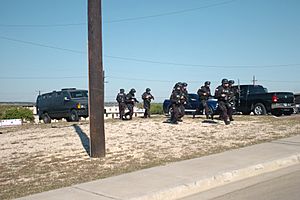
The relative infrequency of SWAT call-outs means these expensively trained and equipped officers cannot be left to sit around, waiting for an emergency. In many departments the officers are normally deployed to regular duties, but are available for SWAT calls via pagers, mobile phones, or radio transceivers. Even in larger police agencies, SWAT personnel will normally be seen in crime suppression roles—specialized and more dangerous than regular patrol, but the officers would not be carrying their distinctive armor and weapons.
Since officers have to be on call-out most of the day, they may be assigned to regular patrol duties. To decrease response times to situations that require a SWAT team, it is now a common practice to place SWAT equipment and weaponry in secured lockers in the trunks of specialized police cruisers instead of forcing officers to travel to gather their equipment or only use a single dedicated SWAT vehicle.
By illustration, the LAPD's website shows that in 2003, their SWAT units were activated 255 times for 133 SWAT calls and 122 times to serve high-risk warrants. The NYPD's Emergency Service Unit is one of the few police special-response units that operate autonomously 24 hours a day. However, this unit also provides a wide range of services in addition to SWAT functions, including search and rescue, and car accident vehicle extrication, normally handled by fire departments or other agencies.
The need to summon widely dispersed personnel, then equip and brief them, makes for a long lag between the initial emergency and actual SWAT deployment on the ground. The problems of delayed police response at Columbine led to changes in police response, mainly rapid deployment of line officers to deal with an active shooter, rather than setting up a perimeter and waiting for SWAT to arrive.
SWAT equipment
SWAT teams use equipment designed for a variety of specialist situations including close-quarters combat (CQC) in an urban environment. The particular pieces of equipment vary from unit to unit, but there are some consistent trends in what they wear and use. Much of their equipment is indistinguishable from that supplied to the military, not least because much of it is military surplus.
Clothing
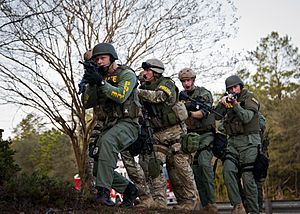
SWAT personnel wear similar uniforms to those worn by military personnel. Traditional SWAT uniforms are usually solid tones of dark blue, black, grey, tan, or olive green, though uniforms with military camouflage have become popular with some SWAT units since the 2000s.
Early SWAT units were equipped with a variety of headgear such as M1 helmets, motorcycle helmets, bump helmets, or even soft patrol caps. Modern SWAT units use helmets similar to those issued by the U.S. military, such as the PASGT helmet or Future Assault Shell Technology helmet, though they may also use riot helmets or soft headgear such as caps. Balaclavas and goggles are often used to protect the face and protect the identities of team members. Ballistic vests, sometimes including rigid plate inserts, are standard-issue. These vests are labelled with "POLICE", "SHERIFF", "SWAT", or similar, to allow for easy identification.
Weapons and equipment
SWAT units are equipped with special weapons that are not normally used by regular police units, typically military firearms such as assault rifles, submachine guns, riot shotguns, sniper rifles, riot control agents, smoke grenades, stun grenades, and stinger grenades. Though these armaments make SWAT teams resemble military infantry squads, they are still law enforcement units tasked with arrest, and are thus often also equipped with less-lethal weapons such as tasers, pepper spray, pepperballs, baton rounds, bean bag rounds, and rubber bullets to incapacitate suspects. Many SWAT units also have access to specialized equipment such as ballistic shields, entry tools, battering rams, armored vehicles, thermal and night-vision devices, fiberscope cameras, and motion detectors.
Canine units may also be incorporated within SWAT teams, or may be used on an ad hoc basis.
Vehicles
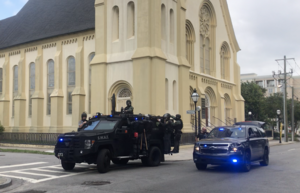
SWAT units often employ SWAT vehicles, also called "armored rescue vehicles" (ARV), for insertion, maneuvering, and during operations such as the rescue of personnel and civilians who may be in danger of receiving fire from suspects if extracted through other methods. Common armored SWAT vehicles include the Lenco BearCat, Lenco BEAR, BAE Caiman, Cadillac Gage Ranger, Cadillac Gage Commando, and similar vehicles. Some departments use decommissioned, disarmed military vehicles acquired from the Law Enforcement Support Office. Alternatively, SWAT teams may use unmarked police cars to respond faster, provide better mobility when splitting up, or avoid detection.
Police aircraft, commonly helicopters, are used to provide aerial reconnaissance or insertion via rappelling or fast-roping.
The use of armored vehicles by SWAT teams is controversial, and it has been alleged that police armored vehicles escalate situations that could otherwise be resolved peacefully. Some smaller police departments and sheriff's departments also acquire armored vehicles despite few incidents occurring in their jurisdictions that would necessitate their use.
See also
 In Spanish: SWAT para niños
In Spanish: SWAT para niños
- List of police tactical units
- Emergency Service Unit
- Special reaction team (U.S. military police)
- SWAT World Challenge
- Militarization of police
- Riot police


